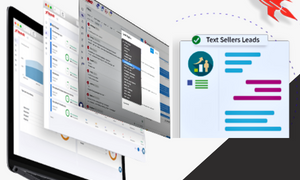Every business strives for long-term profitability, and the latter is impossible without a considerable and predictable lead flow. Leads are core for every company because they are prerequisites for earning revenues.
There’s always a small chance some people may discover and purchase your goods or services all of a sudden. But, in most cases, acquiring a lead is a tough and perpetual process called lead generation.
How Does Lead Generation Work?
Before starting selling and promoting the brand, you have to identify a consumer need to meet. This may include one or several pain points or “wants” of a target audience. With a clear understanding of what problems your products help to solve, you can choose the right communication channels and messages in your marketing strategy.
The lead gen process is impossible without knowing customers’ profiles. To understand how to address leads, you should first create and study “portraits” of buyers. These include demographics and insights about interests, traits, and even daily routines. Typically, the research implies building Buyer persona or key account profiles (the latter concerns B2B lead generation).
When you know everything about the offer’s value and target audience, you can start building awareness and nurturing a purchasing intent among prospects.
All prospects proceed through the so-called “funnel” before they become leads and (hopefully) clients. The lead funnel has 3 groups of stages:
- the top group (TOFU)
- the middle group (MOFU)
- and the bottom group (BOFU).

“A typical funnel for lead generation”, source
TOFU lever is where lead generation begins. Here, the main marketer’s task is to build brand awareness and reach out to as many prospects as a company can afford.
To prevent fruitless outreach and get more qualified leads, you should focus on target segments rather than audiences as a whole. For example, if you use search ads, be sure to include location, language, and at least some demographics parameters in targeting settings.
Ones who have started considering purchase move to the middle of the funnel. Here, lead gen efforts are concentrated on nurturing. Because a sales cycle may be several months long, failing to put enough effort into developing customer relationships equals failing the deal and wasting resources that were spent on acquisitions.
Technically, the lead generation process ends as soon as prospects proceed to the BOFU level. However, to convert leads into customers, you have to distinguish your brand, clearly communicate deals’ terms, and assure excellent customer support. Moreover, if leads pass through BOFU, they may become loyal customers and even brand advocates. This, in turn, will increase an average CLV and result in higher returns on promotional expenses for your company.
Lead Generation Strategies for Marketing Agencies
Every team has its working “formula” on how to attract prospects and convert them into clients.
There are countless marketing tactics – from sporadic paid ads and cold outreach to expensive omnichannel campaigns. But the one thing they all have in common is consistency with the customer journey.
There may be several lead generation strategies going in parallel and serving distinct purposes. For example:
- generating leads with a website
- generating leads with social networks, like LinkedIn or Facebook
- generating leads with an email campaign, etc.
Digital marketing agencies have an advantage over in-house marketing teams as they get solid expertise in different niches. Because they work with many clients, they have a broad field for experiments and analytics, e.g. A\B testing and cohort analysis.
To handle lead gen, agencies apply the following tactics:
- content marketing
They create engaging content for leads, e.g. write or film tutorials and reviews, create educational or entertaining podcasts, place gated content on a website, etc. Content marketing is quite expensive, however, it contributes to the overall reputation and expertise of the brand. Also, unlike advertising campaigns, quality content allows acquiring new leads continuously.
- lead magnets
A working way to attract customers is to offer them something valuable for free – in exchange for contact information. A lead magnet can be put on a landing page or a third-party website. It also can be promoted via social networks.

“Free access is one of the most commonly used on-site lead magnets”, source
A central part of any lead magnet is its utility to end-users. The value may be provided with exclusiveness, time-limited access, cost savings, or all these at once. Lead magnets include free samples, whitepapers, trials, etc.
- PPC campaigns
Advertising is good to retarget prospects or convert leads who have already demonstrated an intent to make a purchase. The most common ad networks include Google and Bing Ads, Facebook, Instagram, and Twitter Ads, YouTube Ads, and Amazon Ads.
- referral marketing
Word-of-mouth is age-old, but who said this makes it work worse? If you can reach out to your existing leads connections, e.g. friends or family members, – do this without a doubt.
The only thing is to choose the accurate procedure and incentive. You can establish a referral program and reward customers for promoting your business to their kins or mates. Remember that a cash reward may not be enough. You should emphasize intangible benefits that other people will get from using your product, such as “proven health gains” or “the fastest delivery on the market”.
Event Lead Generation
Webinars and conferences are particularly helpful for SaaS companies or expert services providers. Content Marketing Institute, HubSpot, Gartner, Sendpulse – these are just a few businesses to name that organize various online events to generate leads from prospects.
Event organizers can pursue multiple objectives:
- promote goods and services (presentations, workshops)
- increase brand awareness (meetups, conferences)
- demonstrate expertise in a certain field (seminars)
- or get conversions (webinars).
Influencers
Social networks and opinion-makers became a part of the daily life of millions of people. Social media accounts for around 4.5 billion users, and the number increases year after year. One way you can reach out to target leads is through building a strong profile. But this may take years and will cost you a fortune. A much faster and a bit cheaper alternative is – to reach out to prospects via bloggers. In other words, to conduct influencer marketing.
There are common approaches for cooperating with influencers:
- giveaways
A giveaway is a contest in which brands offer certain prizes to subscribers in exchange for actions from their side. Giveaways are usually time-limited and are based purely on chance.
- native advertising
This tactic may bring good results in case you cooperate with micro-influencers. Unlike bloggers who have millions of monthly readers, micro-influencers aren’t “unreachable stars” for their subscribers. They seem more authentic and, as a result, followers are eager to follow their recommendations more.
- sponsored post
According to the US FTC, bloggers should disclose partnerships with brands and mark sponsored posts or videos with respective disclaimers or hashtags.

“Bloggers are obliged to mention paid partnerships”, source
Nevertheless, a “paid partnership” post can be a working tactic to generate leads if you choose the right blogger. For example, popular travel search services and booking platforms contract travel bloggers on YouTube to promote their brands.
Marketing Automation
To grow your business, you should optimize processes and operations, including marketing. Manual setups and tracking may work out for a small company or a start-up but they won’t do when you scale up marketing activities or launch bulk campaigns.
To put lead gen on rails, use marketing automation software. With this, you will spend less time on repetitive daily tasks and need fewer marketers to control content distribution, emails, and paid ads.
Marketing automation tools have built-in CRM systems and reporting features. You can utilize them to collect feedback, react to triggers, share updates, etc.
When it comes to generating leads, the automation software will come in handy to perform cold outreach, launch drip campaigns, and create AI chatbots.
Email automation software can boost lead generation in two ways. First, you can use it to search for prospect contacts on the Internet and perform email validation. After, you can utilize a prepared database to reach out to clients manually or schedule a cold outreach campaign.
If your leads database has passed opt-in verification, use email tools to create trigger-based campaigns. For example, when a user drops off an online shopping cart, automatically email him or her a reminder to complete the purchase. Or – create and personalize product offers, according to the client’s previous shopping experience.
Chatbots
Modern chatbots aren’t an array of answers to pre-prepared questions. You can create lead generation chatbots that will simulate human-like conversations. These will identify user needs, “ask” questions and assist users in resolving complex and non-standard issues.
Inbound vs. Outbound Lead Generation Strategies
Who wouldn’t like to receive inquiries from customers rather than impose deals on leads? Inbound lead generation implies that a company creates and shares valuable content, has a convenient and UX-friendly website, does excellent SEO, and effectively manages corporate social profiles. Obviously, this is a resource-consuming strategy. But if a company succeeds with Inbound, the lead flow will increase exponentially.
Outbound lead gen strategy may complement Inbound efforts or be a standalone activity. It includes phone calls, direct mail, social selling, and a few other tactics. Because Outbound activities don’t provide a cumulative effect, it’s recommended to use them in the short term or as temporary tactics – to boost conversions and sales.
Although much has been said about what strategies serve best for lead generation, a truly working scheme is a matter of your personal experience. If you only start, combine Inbound and Outbound tactics – to see which ones bring more leads. And whichever lead gen campaign you launch, don’t forget to track marketing performance metrics.


































